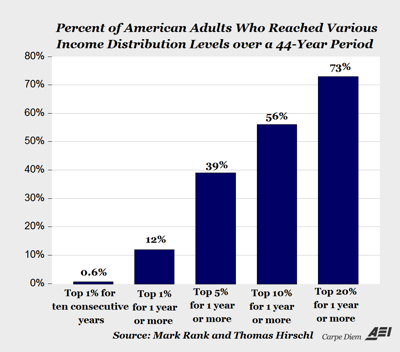 Washington University professor of social welfare Mark Rank presents some amazing findings on income mobility in America: there is dynamic movement up and down the income ladder throughout most of an American’s lifetime. The liberals like to pretend that the wealthy are always wealthy and the poor always poor. That’s incorrect.
Washington University professor of social welfare Mark Rank presents some amazing findings on income mobility in America: there is dynamic movement up and down the income ladder throughout most of an American’s lifetime. The liberals like to pretend that the wealthy are always wealthy and the poor always poor. That’s incorrect.
The picture drawn of the 1 percent has been that of a static population, just as the 99 percent is often portrayed as unchanging. There is a line drawn between these two groups, and never the two shall cross. But is it the case that the top 1 percent of the income distribution are the same people year in and year out? Or, for that matter, what about the top 5, 10 and 20 percent? To what extent do everyday Americans experience these levels of affluence, at least some of the time?
In order to answer such questions, Thomas A. Hirschl of Cornell and I looked at 44 years of longitudinal data regarding individuals from ages 25 to 60 to see what percentage of the American population would experience these different levels of affluence during their lives. The results were striking.
It turns out that 12 percent of the population will find themselves in the top 1 percent of the income distribution for at least one year. What’s more, 39 percent of Americans will spend a year in the top 5 percent of the income distribution, 56 percent will find themselves in the top 10 percent, and a whopping 73 percent will spend a year in the top 20 percent of the income distribution (see those statistics displayed in the chart above).
Yet while many Americans will experience some level of affluence during their lives, a much smaller percentage of them will do so for an extended period of time.Although 12 percent of the population will experience a year in which they find themselves in the top 1 percent of the income distribution, a mere 0.6 percent will do so in 10 consecutive years (see chart).
It is clear that the image of a static 1 and 99 percent is largely incorrect. The majority of Americans will experience at least one year of affluence at some point during their working careers. (This is just as true at the bottom of the income distribution scale, where 54 percent of Americans will experience poverty or near poverty at least once between the ages of 25 and 60).
…………..
Ultimately, this information casts serious doubt on the notion of a rigid class structure in the United States based upon income. It suggests that the United States is indeed a land of opportunity, that the American dream is still possible — but that it is also a land of widespread poverty.And rather than being a place of static, income-based social tiers, America is a place where a large majority of people will experience either wealth or poverty — or both — during their lifetimes.
Rather than talking about the 1 percent and the 99 percent as if they were forever fixed, it would make much more sense to talk about the fact that Americans are likely to be exposed to both prosperity and poverty during their lives, and to shape our policies accordingly. As such, we have much more in common with one another than we dare to realize.
Via AEI